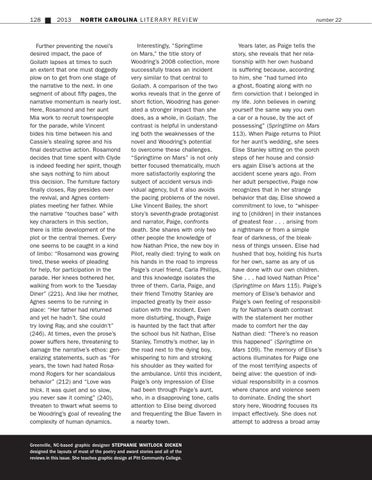128
2013
NORTH CAROLINA L I T E R A R Y RE V I E W
Further preventing the novel’s desired impact, the pace of Goliath lapses at times to such an extent that one must doggedly plow on to get from one stage of the narrative to the next. In one segment of about fifty pages, the narrative momentum is nearly lost. Here, Rosamond and her aunt Mia work to recruit townspeople for the parade, while Vincent bides his time between his and Cassie’s stealing spree and his final destructive action. Rosamond decides that time spent with Clyde is indeed feeding her spirit, though she says nothing to him about this decision. The furniture factory finally closes, Ray presides over the revival, and Agnes contemplates meeting her father. While the narrative “touches base” with key characters in this section, there is little development of the plot or the central themes. Everyone seems to be caught in a kind of limbo: “Rosamond was growing tired, these weeks of pleading for help, for participation in the parade. Her knees bothered her, walking from work to the Tuesday Diner” (221). And like her mother, Agnes seems to be running in place: “Her father had returned and yet he hadn’t. She could try loving Ray, and she couldn’t” (246). At times, even the prose’s power suffers here, threatening to damage the narrative’s ethos: generalizing statements, such as “For years, the town had hated Rosamond Rogers for her scandalous behavior” (212) and “Love was thick. It was quiet and so slow, you never saw it coming” (240), threaten to thwart what seems to be Woodring’s goal of revealing the complexity of human dynamics.
Interestingly, “Springtime on Mars,” the title story of Woodring’s 2008 collection, more successfully traces an incident very similar to that central to Goliath. A comparison of the two works reveals that in the genre of short fiction, Woodring has generated a stronger impact than she does, as a whole, in Goliath. The contrast is helpful in understanding both the weaknesses of the novel and Woodring’s potential to overcome these challenges. “Springtime on Mars” is not only better focused thematically, much more satisfactorily exploring the subject of accident versus individual agency, but it also avoids the pacing problems of the novel. Like Vincent Bailey, the short story’s seventh-grade protagonist and narrator, Paige, confronts death. She shares with only two other people the knowledge of how Nathan Price, the new boy in Pilot, really died: trying to walk on his hands in the road to impress Paige’s cruel friend, Carla Phillips, and this knowledge isolates the three of them. Carla, Paige, and their friend Timothy Stanley are impacted greatly by their association with the incident. Even more disturbing, though, Paige is haunted by the fact that after the school bus hit Nathan, Elise Stanley, Timothy’s mother, lay in the road next to the dying boy, whispering to him and stroking his shoulder as they waited for the ambulance. Until this incident, Paige’s only impression of Elise had been through Paige’s aunt, who, in a disapproving tone, calls attention to Elise being divorced and frequenting the Blue Tavern in a nearby town.
Greenville, NC-based graphic designer Stephanie Whitlock Dicken designed the layouts of most of the poetry and award stories and all of the reviews in this issue. She teaches graphic design at Pitt Community College.
number 22
Years later, as Paige tells the story, she reveals that her relationship with her own husband is suffering because, according to him, she “had turned into a ghost, floating along with no firm conviction that I belonged in my life. John believes in owning yourself the same way you own a car or a house, by the act of possessing” (Springtime on Mars 113). When Paige returns to Pilot for her aunt’s wedding, she sees Elise Stanley sitting on the porch steps of her house and considers again Elise’s actions at the accident scene years ago. From her adult perspective, Paige now recognizes that in her strange behavior that day, Elise showed a commitment to love, to “whispering to [children] in their instances of greatest fear . . . arising from a nightmare or from a simple fear of darkness, of the bleakness of things unseen. Elise had hushed that boy, holding his hurts for her own, same as any of us have done with our own children. She . . . had loved Nathan Price” (Springtime on Mars 115). Paige’s memory of Elise’s behavior and Paige’s own feeling of responsibility for Nathan’s death contrast with the statement her mother made to comfort her the day Nathan died: “There’s no reason this happened” (Springtime on Mars 109). The memory of Elise’s actions illuminates for Paige one of the most terrifying aspects of being alive: the question of individual responsibility in a cosmos where chance and violence seem to dominate. Ending the short story here, Woodring focuses its impact effectively. She does not attempt to address a broad array
